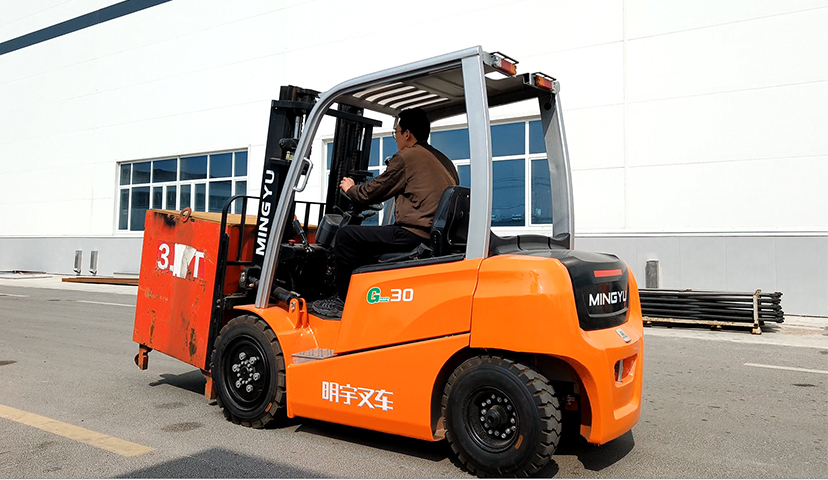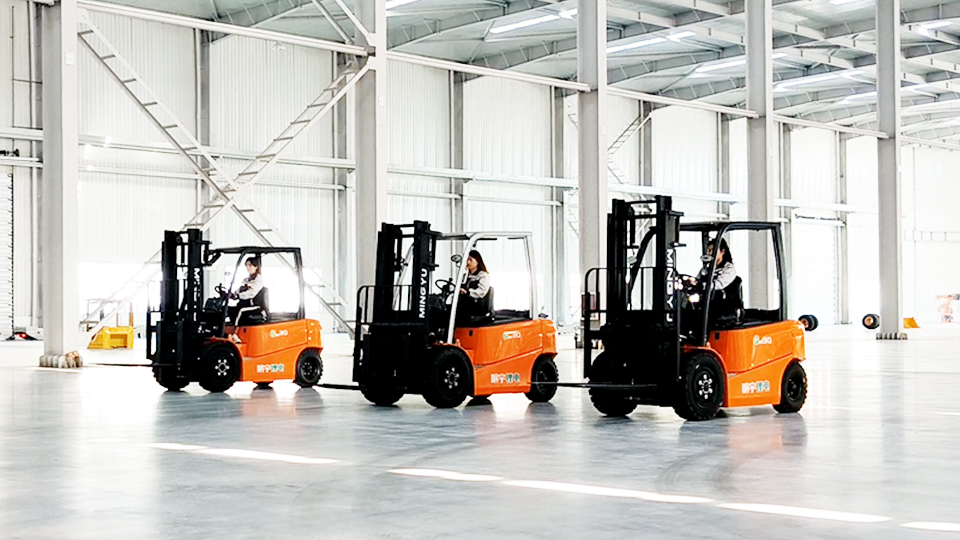
Can Lithium-Ion Forklifts Operate in Cold Storage ($-20^\circ \text{C}$) Environments?
A Technical Analysis of $\text{LiFePO}_4$ Performance and Cold-Conditioning Requirements
The cold storage and frozen food logistics sector presents one of the most demanding operational environments for material handling equipment.1 Temperatures routinely plummet to $-20^\circ \text{C}$ ($-4^\circ \text{F}$) and can even reach $-30^\circ \text{C}$ ($-22^\circ \text{F}$). These extreme conditions accelerate wear on mechanical components, thicken hydraulic fluids, and, most critically, stress the forklift's power source.2
While conventional wisdom long dictated the use of specialized diesel equipment or heavily managed lead-acid batteries, the answer to whether lithium-ion (Li-ion) forklifts can operate effectively in these sub-zero environments is a definitive yes, provided the equipment is engineered with the necessary cold-conditioning technology. Modern Li-ion solutions, specifically those utilizing Lithium Iron Phosphate ($\text{LiFePO}_4$) chemistry and integrated heating systems, are now proving to be the superior choice, fundamentally overcoming the capacity and maintenance limitations inherent to traditional power sources in the deep freeze.
1. The Challenge of Cold: Electrochemical and Physical Effects
Extreme cold poses two primary technical challenges to any battery system: electrochemical degradation and physical component stress.
1.1 Electrochemical Slowdown (Capacity Loss)
All battery chemistries, including 3$\text{LiFePO}_4$, rely on the movement of ions through an electrolyte to generate power.4 As temperature decreases, the electrochemical reactions slow down significantly:5

Electrolyte Viscosity: At 6$-20^\circ \text{C}$, the viscosity of the electrolyte increases, effectively reducing its ionic conductivity.7 This impedes the speed at which lithium ions (8$\text{Li}^+$) can migrate between the cathode and anode.9
Increased Internal Resistance: The reduction in ion mobility leads to a sharp increase in the battery's internal resistance (10$R_i$).11 A higher $R_i$ means more energy is wasted as heat during both discharge and charge, reducing the overall usable capacity and efficiency of the system.
Capacity Reduction: Unprotected 12$\text{LiFePO}_4$ batteries may experience a temporary capacity loss of 13$30\%$ to 14$50\%$ when discharging at 15$-20^\circ \text{C}$ compared to their rated capacity at 16$25^\circ \text{C}$.17 This temporary loss shortens the runtime drastically.
1.2 The Critical Charging Prohibition ($\text{0}^\circ \text{C}$)
The most severe danger in cold operation is attempting to charge a Li-ion battery below the freezing point of water (18$0^\circ \text{C}$ or 19$32^\circ \text{F}$):20
Lithium Plating: When the battery is charged at low temperatures, the lithium ions cannot easily intercalate (insert) into the graphite anode structure due to the sluggish kinetics.21 Instead, the ions deposit on the anode surface as metallic lithium, a process known as lithium plating.22
Irreversible Damage: Lithium plating is irreversible, causing permanent capacity fade and, critically, posing a significant safety risk (potential for internal shorts and thermal events).23 This is the fundamental reason why standard Li-ion battery management systems (BMS) are programmed to prevent charging below a critical temperature threshold, typically 24$0^\circ \text{C}$ or 25$5^\circ \text{C}$.26
2. Li-ion vs. Lead-Acid in Cold Storage
While both battery types suffer capacity loss, the Li-ion system is fundamentally superior in operational flexibility and long-term TCO for cold environments.27
2.1 Lead-Acid Limitations in the Freeze
Massive Capacity Loss: Lead-acid batteries lose an even greater percentage of usable capacity (often $35\%$ to $50\%$) at freezing temperatures.
Required Maintenance: Lead-acid batteries require regular watering, which is logistically complex and potentially hazardous in freezer zones.28
Condensation Risk: To charge and cool, lead-acid batteries must be removed from the freezer and placed in a dedicated, often warm, charging room.29 This forces the forklift to undergo extreme temperature cycling, leading to severe condensation inside the chassis, which causes corrosion, icing, and electrical component failure.30
No Opportunity Charging: Opportunity charging, which is vital for multi-shift operation, drastically shortens the lifespan of lead-acid batteries.31
2.2 Lithium-Ion Advantages
Superior Capacity Retention: While they do lose some capacity, Li-ion batteries retain a significantly higher percentage of their available power compared to lead-acid at the same sub-zero temperature.32
Maintenance-Free: No watering or equalization is required, eliminating complex labor tasks in the freezer.
Opportunity Charging: Li-ion allows for charging during short breaks, reducing the total capacity required and eliminating the need for battery swaps.33
3. The Technical Solution: Integrated Thermal Management Systems
For a Li-ion forklift to operate reliably and continuously in a $-20^\circ \text{C}$ freezer, the battery cannot rely solely on its inherent chemistry. It must be equipped with an integrated Thermal Management System (TMS).34
3.1 Components of the Cold-Conditioned Li-ion System
The modern cold-storage Li-ion solution consists of three critical engineered features:
Internal Heating Element (PTC Heaters):
Function: Specialized Positive Temperature Coefficient (35$\text{PTC}$) heating pads or blankets are integrated directly into the battery modules or placed around the pack.36
Activation: The internal BMS constantly monitors the cell temperature.37 If the temperature drops below a critical threshold (e.g., 38$5^\circ \text{C}$ or 39$\text{T}_{crit}$), the 40$\text{PTC}$ heaters are activated, often drawing power directly from the battery itself or the charger.41
Purpose: The sole purpose of the heating system is to raise the internal cell temperature above $0^\circ \text{C}$ (and ideally up to $20^\circ \text{C}$) before allowing a charge cycle to commence. This protects the battery from irreversible lithium plating damage.

High-Grade Thermal Insulation:
Function: The battery pack is wrapped in a thick, multi-layered thermal insulation material (e.g., specialized foams or 42$\text{PE}$ insulation cotton).43
Purpose: This insulation minimizes heat loss to the ambient 44$-20^\circ \text{C}$ environment.45 It traps the waste heat naturally generated during high-current discharging, allowing the battery to maintain a functional internal temperature for extended periods without relying solely on the $\text{PTC}$ heaters.
High Ingress Protection (IP Rating):
Function: The battery enclosure, connectors, and wiring utilize robust, sealed components with specialized waterproof glands and sealing rings.
Rating Requirement: Forklifts operating in cold storage must meet high IP ratings, typically IP65 or higher, with some specialized batteries achieving IP67.46
Purpose: This sealing prevents the ingress of moisture, ice, and dust, which is critical because rapid temperature changes (e.g., moving from $-20^\circ \text{C}$ to a $0^\circ \text{C}$ airlock) induce condensation that could otherwise cause short circuits or corrosion in the electronics. Desiccant packs are sometimes integrated internally to absorb residual moisture.47
$$\text{Cold Storage Solution} = \text{LiFePO}_4 + \text{BMS} (\text{Heater Control}) + \text{IP65+/Insulation}$$
4. Operational Protocols for Cold Storage
Effective operation of Li-ion forklifts in $-20^\circ \text{C}$ environments relies on specific operational protocols that leverage the technical advantages of the system:
4.1 In-Freezer Charging
With the integrated heating system, a Li-ion forklift can be charged while remaining inside the 48$-20^\circ \text{C}$ freezer or in a minimally warmer transitional zone.49
Process: The operator connects the charger.50 The BMS detects the temperature is below $0^\circ \text{C}$ and prioritizes powering the $\text{PTC}$ heaters. Once the internal temperature reaches the charging threshold (e.g., $5^\circ \text{C}$), the BMS permits the flow of current to the cells.
Benefit: Eliminating the need to cycle the forklift out to an ambient charging room minimizes condensation risk and maximizes uptime, as the truck can receive opportunity charges during breaks.51
4.2 Extended Runtime and Productivity
The higher energy density and superior efficiency retention of Li-ion mean that a single battery can often support a full 8-hour shift, even at $-20^\circ \text{C}$. This eliminates the need for two or three spare lead-acid batteries per truck, reclaiming valuable cold-storage space.52
4.3 Full Cold-Conditioning of the Forklift
The battery is only one part of the challenge. For $-20^\circ \text{C}$ operation, the entire forklift must be cold-conditioned:
Hydraulics: Must use special low-viscosity, cold-rated hydraulic oils to prevent sluggish movement.53
Seals and Wiring: All rubber seals, gaskets, and wiring must be made of cold-resistant materials to prevent cracking or brittleness.
Corrosion Protection: Exposed metal components require advanced anti-corrosion treatments (e.g., galvanization) to resist the combined corrosive effects of low temperature and high humidity/condensation.54
5. Technical Conclusion
Lithium-ion forklifts are not merely capable of operating in $-20^\circ \text{C}$ cold storage; when properly specified and equipped, they represent the technically superior and most cost-effective solution for this environment.
While the inherent chemical properties of $\text{LiFePO}_4$ lead to temporary performance limitations at sub-zero temperatures, these are mitigated by sophisticated Thermal Management Systems and high-level IP sealing. The ability to safely charge inside the freezer (or transitional zones) prevents the major operational hazards associated with lead-acid systems, such as condensation-induced corrosion and capacity failure.55
For cold storage environments where maximizing uptime and minimizing maintenance is paramount, the initial investment in a $\text{LiFePO}_4$ forklift with an integrated heater is the necessary technical requirement for achieving long-term operational excellence.
Name: selena
Mobile:+86-13176910558
Tel:+86-0535-2090977
Whatsapp:8613181602336
Email:vip@mingyuforklift.com
Add:Xiaqiu Town, Laizhou, Yantai City, Shandong Province, China